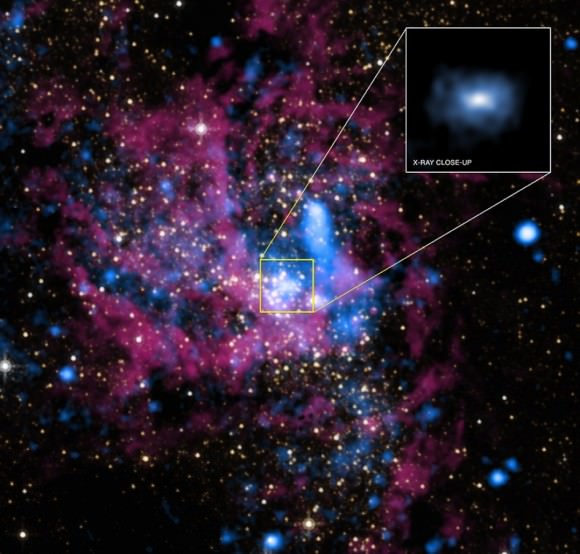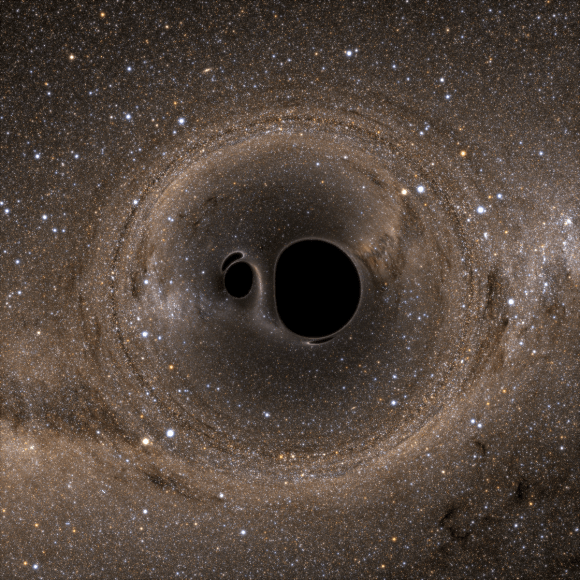Below we have 10 mind-blowing facts about black holes -
1)You can’t directly see a black hole -
Because of it's immense gravitational force- no light can escape from it . It is impossible for us to feel the hole directly through our instruments, regardless of the type of electromagnetic radiation you use (light, X-rays, whatever.) The key is to look at the effects of the black hole on the neighbouring environment, stresses NASA. Let's say a star is too close to the black hole, for example. The black hole shoots naturally on the star and rips it into shreds. When the matter of the star begins to move towards the black hole, it becomes faster, gets hotter and glows brightly in the X-rays.
2)Look out! Our Milky Way has a black hole -
A subsequent natural question is given how dangerous a black hole is, is the Earth in imminent danger of being swallowed? The answer is no, astronomers say, although there is probably a huge supermassive black hole lurking in the middle of our galaxy. Fortunately, we are far from this monster, we are about two thirds of the way out of the center, compared to the rest of our galaxy, but we can certainly observe its effects from afar. For example: the European Space Agency says it is 4 million times more massive than our sun, and is surrounded by surprisingly hot gas.
3)Dying stars create black holes-
Let's say you have a star that is about 20 times more massive than the sun. Our sun will put an end to its life quietly; When its nuclear fuel burns, it will slowly fade into a white dwarf. This is not the case for much more massive stars. When these monsters run out of fuel, gravity will overwhelm the natural pressure of the star maintains to keep its shape stable. When the pressure of nuclear reactions collapses, Gravity submerges violently and collapses the nucleus and other layers are thrown into space. It's called a supernova. The remaining nucleus collapses into a singularity - a spot with infinite density and almost no volume. It is another name for a black hole.
4)Black holes come in a range of sizes-
There are at least three types of black holes, says Nasa, ranging from squeaks relative to those dominating a center of the galaxy. The primal black holes are the smallest, and range from the size of an atom to the mass of a mountain. Stellar black holes, the most common type, are up to 20 times more massive than our own sun and are probably sprinkled in the dozens in the Milky Way. And then there are the gigantic in the centers of galaxies, called "supermassive black holes". They are each more than 1 million times more massive than the sun. How these monsters formed is still being examined.
This is best illustrated by one person (call him A) falling into a black hole while another person (call them B) watches. From B’s perspective, A's clock appears to be ticking slower and slower . This is in accordance with Einstein’s theory of general relativity, which (in short) says that time is affected by how fast we go, when you’re at extreme speeds close to light. The black hole warps time and space so much that A’s time appears to be running slower. From B’s perspective, however, his clock is running normally and Lucky’s is running fast.
6)The first black hole wasn’t discovered until X-ray astronomy was used-
Cygnus X-1 was found during balloon flights in the 1960s, but wasn’t identified as a black hole for another decade. According to NASA, the black hole is 10 times more massive than our Sun. Nearby is a blue supergiant star that is about 20 times more massive than the Sun, which is bleeding due to the black hole and creating X-ray emissions.

Illustration of Cygnus X-1, another stellar-mass black hole located 6070 ly away. Credit: NASA/CXC/M.Weiss
7)The nearest black hole is likely not 1,600 light-years away-
An erroneous measurement of V4641 Sagitarii led to a slew of news reports 10 years back saying that the nearest black hole to Earth was astoundingly close, just 1,600 light-years away. Not close enough to be considered dangerous, but way closer than we thought. Further research, however, shows that the black hole is likely further away than that. Looking at the rotation of its companion star , yielded a result of more than 20,000 light years.
8)We aren’t sure if wormholes exist-
A popular science-fiction theory concerns what happens if somebody falls into a black hole. Some people believe these objects are a sort of wormhole to other parts of the Universe, making faster-than-light travel possible. But as this Smithsonian Magazine article points out, anything is possible since we still have a lot to figure out about physics. “Since we do not yet have a theory that reliably unifies general relativity with quantum mechanics, we do not know of the entire zoo of possible spacetime structures that could accommodate wormholes,” said Abi Loeb, Harvard-Smithsonian Center for Astrophysics.

Diagram of a wormhole, or theoretical shortcut path between two locations in the universe. Credit: Wikipedia
Fact 9: Black holes are only dangerous if you get too close-
It’s okay to observe a black hole if you stay away from its event horizon — think of it like the gravitational field of a planet. This zone is the point of no return, when you’re too close for any hope of rescue. But you can safely observe the black hole from outside of this area. By extension, this means it’s likely impossible for a black hole to swallow up everything in the Universe.
Fact 10: Black holes are used all the time in science fiction-
There are so many films and movies using black holes, for example, that it’s impossible to list them all. Interstellar‘s journeys through the universe includes a close-up look at a black hole. Event Horizon explores the phenomenon of artificial black holes — something that is also discussed in the Star Trek universe. Black holes are also talked about in Battlestar: Galactica, Stargate: SG1 and many other space shows.







The entire Marvel Cinematic Universe? I mean unless you count those teleportation portals used by Thanos that is
ReplyDeleteYeah but wormholes are just theories but they have not been proven . But one day we might be able to time travel.
DeleteMan you are rocking
ReplyDeletetrue....
DeleteVery interesting information. The pics are also quite captivating. Thanks. Pishe....i
ReplyDelete